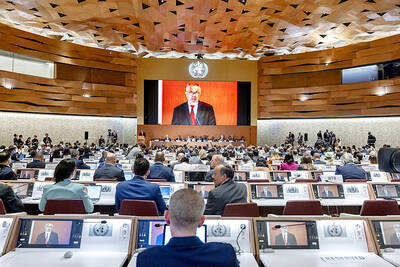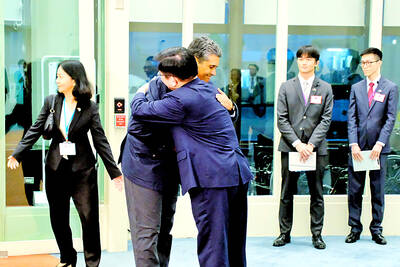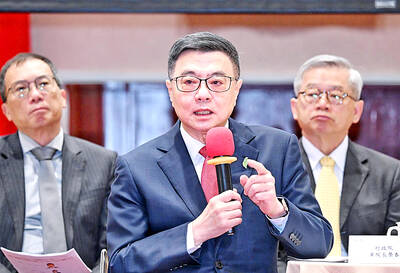Taiwan is set to formally become an aging society in 2017, with the number of people aged 65 years and older accounting for 14 percent of the population, a Council for Economic Planning and Development (CEPD) official said yesterday.
Wang Ling (王玲), a CEPD section chief in charge of manpower planning, made the remarks one day after the council unveiled a report on the country’s projected demographic development from this year through 2056.
Citing the report, Wang said the population is aging far faster than many advanced countries.
By the UN’s definition, Taiwan’s population began graying in 1993 when the ratio of elderly citizens reached 7 percent of the total population for the first time.
“It has taken just an estimated 24 years for Taiwan to turn from graying to aging, compared with 50 to 100 years in Western countries,” Wang said.
The CEPD forecast that the country may even become an “ultra-aging society” by 2025, when people over 65 will account for 20 percent of the total population.
With the population aging rapidly, Wang said, the country’s aged dependency ratio could surpass the youth dependency ratio for the first time in five years.
The aged dependency ratio — the number of actively working people divided by the number of aged dependents — is a common measure for gauging the burden of an aging society.
This year’s statistics show that on average there are seven active workers supporting each elderly person, the CEPD report showed. It forecast that by 2026, the ratio would drop to 3.2 workers per elderly citizen. It also predicted that the figure would drop further to 1.4 active workers for every “aged dependent.”
The CEPD estimated that the ratio of people aged 65 and older would surge from this year’s 10.4 percent of the total population to 14.7 percent by 2018 and to 37.5 percent by 2056.
Moreover, the number of “ultra-old” persons — those over 75 years old — will surge from this year’s 1.03 million to 4.55 million by 2056, the CEPD said. The ratio of ultra-old citizens to the elderly population — aged 65 and older — is also forecast to increase from 43.1 percent to 59.7 percent over the same period.
While the elderly population continues to grow, the CEPD report said, women’s total fertility rate has fallen below the replacement level.
Statistics compiled by the Ministry of the Interior (MOI) showed the fertility rate dropped to 1.1 children per woman last year, from 1.77 a decade ago.
Contributing factors are late marriage and a declining marriage rate among women of childbearing age, effectively resulting in shorter childbearing periods, ministry figures showed.
The MOI’s latest demographic report said that the marriage rate among women in the 35 to 39 age group declined from 82.6 percent in 1997 to 71.2 percent last year. During the same period, the average age of local women giving birth to their first child rose from 26.3 years old to 28.5 years old.
In the face of the growing demographic imbalance, the CEPD, in its newly drafted demographic report, has come up with various policy initiatives such as encouraging marriage and childbearing and creating an environment favorable to the formation of households.
CEPD officials said the major target of the new policy initiatives is to gradually raise the fertility rate — which has remained at 1.1 per woman for the past three years — to 1.4.
The latest CEPD report also forecast that Taiwan’s population would peak at 23.837 million at the end of 2026, the officials said.

RESOLUTIONS DEBATE: Taiwan’s allies said that UN and WHA resolutions cited by China and other nations ‘do not determine Taiwan’s participation in WHO activities’ A proposal to invite Taiwan to this year’s World Health Assembly (WHA) was rejected on Monday, resulting in Taipei’s absence from the annual meeting for a ninth consecutive year, although partners spoke up for Taiwan’s participation at the first day of the meeting. The first agenda item after the opening was a “two-on-two debate” on a proposal to invite Taiwan to participate at the WHA as an observer. Similar to previous years, two countries made statements in favor of the proposal, while two others expressed their opposition. Philippine Secretary of Health Teodoro Herbosa, president of the 78th WHA, accepted the WHA General Committee’s

Palauan President Surangel Whipps Jr arrived in Taiwan last night to kick off his first visit to the country since beginning his second term earlier this year. After arriving at Taoyuan International Airport at around 6:30 pm, Whipps and his delegation were welcomed by Minister of Foreign Affairs Lin Chia-lung (林佳龍). Speaking to gathered media, the Palauan leader said he was excited and honored to be back in Taiwan on his first state visit to Taiwan since he was sworn in this January. Among those traveling with Whipps is Minister of State Gustav N. Aitaro, Public Infrastructure

Premier Cho Jung-tai (卓榮泰) on Friday laid out the Cabinet’s updated policy agenda and recapped the government’s achievements ahead of the one-year anniversary of President William Lai’s (賴清德) inauguration. Cho said the government had made progress across a range of areas, including rebuilding Hualien, cracking down on fraud, improving pedestrian safety and promoting economic growth. “I hope the public will not have the impression that the Cabinet only asked the legislature to reconsider a bunch of legal amendments,” Cho said, calling the moves “necessary” to protect constitutional governance and the public’s interest. The Cabinet would work toward achieving its “1+7” plan, he said. The

Nvidia founder and CEO Jensen Huang (黃仁勳) hosted a dinner in Taipei last night with key Taiwanese suppliers to celebrate the successful mass production of the company’s new Blackwell AI systems. Speaking to the media earlier yesterday, Huang thanked Nvidia’s Taiwanese partners for their contributions to the company’s ecosystem, while also sharing his plans to meet with Taiwan Semiconductor Manufacturing Co (TSMC) founder Morris Chang (張忠謀). In response to rumors that Nvidia will launch a downgraded Hopper H20 chip for China in July, Huang dismissed the reports, saying, “That is not true.” He clarified that there